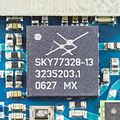Amplifier
The word amplifier (sometimes called an amp) usually refers to an electronic amplifier. Electronic amplifiers make a signal from a radio or electric musical instrument (such as an electric guitar or an electric bass guitar) louder and stronger. Amplifiers are also hidden in any electronic thing that makes sound with loudspeakers. This includes televisions, radios, computers, and mp3 players, to name a few.
Amplifiers ability to use low impedance speakers may vary. Typical impedance is 8 ohms.
Classification can be done by current loss when amplifier is on but does not get signal. Example: A-class amplifier takes more current without signal than B-class amplifier but A-class amplifier have smaller distortion.
There is also several distortion types.
How it works
Electronic amplifiers make a signal from the radio or electric instrument louder and stronger by using transistors or vacuum tubes. Electronic amplifiers have to be connected to electrical current or a battery to work. Once the signal from the radio or electric instrument has been made louder and stronger, the signal needs to be connected to a loudspeaker so that people can hear it.
When an amplifier tries to make the sound louder than it can, it adds distortion to the sound. Some amplifiers are made to add controlled distortion. Distortion from transistors sounds different than distortion from tubes. Distortion from tubes is often said to be more musical. Because of all this, more expensive amplifiers often add controlled distortion with tubes. Many of these amplifiers use transistors for a "clean" sound (without distortion).
History
From the 1920s until the 1950s, electronic amplifiers used vacuum tubes. However, electronic amplifiers with vacuum tubes were heavy, and they produced a lot of heat. They also broke down a lot.
Since the 1960s, most electronic amplifiers have been built with transistors. Transistors are lighter, cheaper, and more reliable.
Amplifier Media
A McIntosh stereo audio amplifier with output power of 50 watts per channel used in home component audio systems in the 1970s.
De Forest's prototype audio amplifier of 1914. The Audion (triode) vacuum tube had a voltage gain of about 5, providing a total gain of approximately 125 for this three-stage amplifier.
Power amplifier by Skyworks Solutions in a Smartphone.
An LM741 general purpose op-amp
| Wikimedia Commons has media related to Lua error in Module:Commons_link at line 62: attempt to index field 'wikibase' (a nil value).. |







